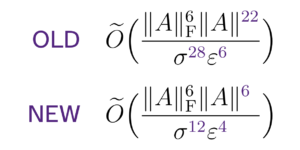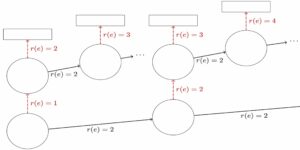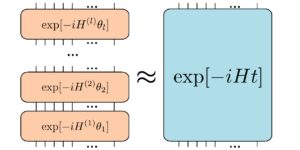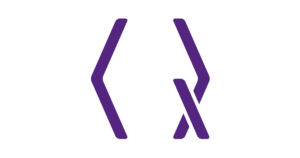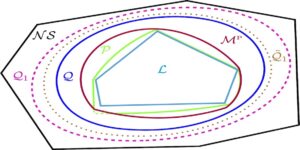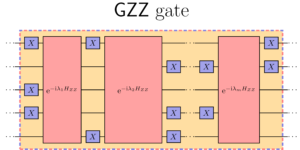1Department of Physics of Complex Systems, S.N. Bose National Center for Basic Sciences, Block JD, Sector III, Salt Lake, Kolkata 700106, India.
2Laboratoire d’Information Quantique, Université libre de Bruxelles (ULB), Av. F. D. Roosevelt 50, 1050 Bruxelles, Belgium
3Department of Computer Science, The University of Hong Kong, Pokfulam Road, Hong Kong.
4International Centre for Theory of Quantum Technologies, University of Gdansk, Wita Stwosza 63, 80-308 Gdansk, Poland.
Find this paper interesting or want to discuss? Scite or leave a comment on SciRate.
Abstract
We analyze utility of communication channels in absence of any short of quantum or classical correlation shared between the sender and the receiver. To this aim, we propose a class of two-party communication games, and show that the games cannot be won given a noiseless $1$-bit classical channel from the sender to the receiver. Interestingly, the goal can be perfectly achieved if the channel is assisted with classical shared randomness. This resembles an advantage similar to the quantum superdense coding phenomenon where pre-shared entanglement can enhance the communication utility of a perfect quantum communication line. Quite surprisingly, we show that a qubit communication without any assistance of classical shared randomness can achieve the goal, and hence establishes a novel quantum advantage in the simplest communication scenario. In pursuit of a deeper origin of this advantage, we show that an advantageous quantum strategy must invoke quantum interference both at the encoding step by the sender and at the decoding step by the receiver. We also study communication utility of a class of non-classical toy systems described by symmetric polygonal state spaces. We come up with communication tasks that can be achieved neither with $1$-bit of classical communication nor by communicating a polygon system, whereas $1$-qubit communication yields a perfect strategy, establishing quantum advantage over them. To this end, we show that the quantum advantages are robust against imperfect encodings-decodings, making the protocols implementable with presently available quantum technologies.
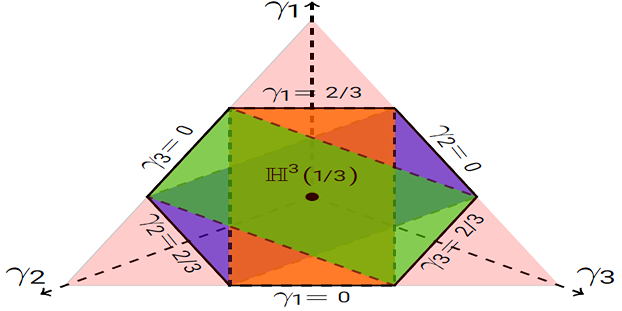
Featured image: Parameter-space ($gamma_1+gamma_2+gamma_3=1$ plane) of the games $mathbb{H}^3(gamma_1,gamma_2,gamma_3)$. Orange shaded regions are the unphysical games as the conditions ($mathrm{h}1^prime)$ and ($mathrm{h}2^prime)$ cannot be satisfied for the parameters values chosen from there. The green shaded region (polytope) are all games winnable with correlated strategies with $1$-bit of shared randomness. The boundaries of the green polytope, i.e. $gamma_i=0~mbox{and}~2/3,~mbox{for}~iin{1,2,3}$, are the only games winnable with classical mixed strategies.
Popular summary
► BibTeX data
► References
[1] C. E. Shannon; A mathematical theory of communication, Bell Syst. Tech. J. 27, 379 (1948).
https://doi.org/10.1002/j.1538-7305.1948.tb01338.x
[2] M. A. Nielsen and I. L. Chuang; Quantum Computation and Quantum Information (Cambridge University Press, Cambridge, England, 2010).
[3] J. P. Dowling and G. J. Milburn; Quantum technology: the second quantum revolution, Phil. Trans. R. Soc. Lond. A 361, 1655 (2003).
https://doi.org/10.1098/rsta.2003.1227
[4] C. H. Bennett and S. J. Wiesner; Communication via one- and two-particle operators on Einstein-Podolsky-Rosen states, Phys. Rev. Lett. 69, 2881 (1992).
https://doi.org/10.1103/PhysRevLett.69.2881
[5] C. H. Bennett, G. Brassard, C. Crépeau, R. Jozsa, A. Peres, and W. K. Wootters; Teleporting an unknown quantum state via dual classical and Einstein-Podolsky-Rosen channels, Phys. Rev. Lett. 70, 1895 (1993).
https://doi.org/10.1103/PhysRevLett.70.1895
[6] C. H. Bennett and D. DiVincenzo; Quantum information and computation, Nature 404, 247 (2000).
https://doi.org/10.1038/35005001
[7] H. J. Kimble; The quantum internet, Nature 453, 1023 (2008).
https://doi.org/10.1038/nature07127
[8] H. Dale, D. Jennings, and T. Rudolph; Provable quantum advantage in randomness processing, Nat. Commun. 6, 8203 (2015).
https://doi.org/10.1038/ncomms9203
[9] W. Zhang, D-S Ding, Y-B Sheng, L. Zhou, B-S Shi, and G-C Guo; Quantum Secure Direct Communication with Quantum Memory, Phys. Rev. Lett. 118, 220501 (2017).
https://doi.org/10.1103/PhysRevLett.118.220501
[10] P. Boes, H. Wilming, R. Gallego, and J. Eisert; Catalytic Quantum Randomness, Phys. Rev. X 8, 041016 (2018).
https://doi.org/10.1103/PhysRevX.8.041016
[11] D. Rosset, F. Buscemi, and Y-C. Liang; Resource Theory of Quantum Memories and Their Faithful Verification with Minimal Assumptions, Phys. Rev. X 8, 021033 (2018).
https://doi.org/10.1103/PhysRevX.8.021033
[12] D. Ebler, S. Salek, and G. Chiribella; Enhanced Communication with the Assistance of Indefinite Causal Order, Phys. Rev. Lett. 120, 120502 (2018).
https://doi.org/10.1103/PhysRevLett.120.120502
[13] K. Korzekwa and M. Lostaglio; Quantum Advantage in Simulating Stochastic Processes, Phys. Rev. X 11, 021019 (2021).
https://doi.org/10.1103/PhysRevX.11.021019
[14] G. Chiribella, M. Banik, S. S. Bhattacharya, T. Guha, M. Alimuddin, A. Roy, S. Saha, S. Agrawal, and G. Kar; Indefinite causal order enables perfect quantum communication with zero capacity channels, New J. Phys. 23, 033039 (2021).
https://doi.org/10.1088/1367-2630/abe7a0
[15] S. S. Bhattacharya, A. G. Maity, T. Guha, G. Chiribella, and M. Banik; Random-Receiver Quantum Communication, PRX Quantum 2, 020350 (2021).
https://doi.org/10.1103/PRXQuantum.2.020350
[16] S. Koudia, A. S. Cacciapuoti, and M. Caleffi; How Deep the Theory of Quantum Communications Goes: Superadditivity, Superactivation and Causal Activation, IEEE Commun. Surv. Tutor. 24 (4), 1926-1956 (2022).
https://doi.org/10.1109/COMST.2022.3196449
[17] D. Bouwmeester, J. W. Pan, K. Mattle, M. Eibl, H. Weinfurter, and A. Zeilinger; Experimental quantum teleportation, Nature 390, 575 (1997).
https://doi.org/10.1038/37539
[18] N. Gisin, G. Ribordy, W. Tittel, and H. Zbinden; Quantum Cryptography, Rev. Mod. Phys. 74, 145 (2002).
https://doi.org/10.1103/RevModPhys.74.145
[19] I. M. Georgescu, S. Ashhab, and F. Nori; Quantum Simulation, Rev. Mod. Phys. 86, 153 (2014).
https://doi.org/10.1103/RevModPhys.86.153
[20] C. L. Degen, F. Reinhard, and P. Cappellaro; Quantum Sensing, Rev. Mod. Phys. 89, 035002 (2017).
https://doi.org/10.1103/RevModPhys.89.035002
[21] J. Yin et al. Satellite-based entanglement distribution over 1200 kilometers, Science 356, 1140 (2017).
https://doi.org/10.1126/science.aan3211
[22] R. Valivarthi et al. Teleportation Systems Toward a Quantum Internet, PRX Quantum 1, 020317 (2020).
https://doi.org/10.1103/PRXQuantum.1.020317
[23] F. Xu, X. Ma, Q. Zhang, H-K Lo, and J-W Pan; Secure quantum key distribution with realistic devices, Rev. Mod. Phys. 92, 025002 (2020).
https://doi.org/10.1103/RevModPhys.92.025002
[24] A. S. Holevo; Bounds for the Quantity of Information Transmitted by a Quantum Communication Channel, Problems Inform. Transmission 9, 177 (1973).
http://www.mathnet.ru/php/archive.phtml?wshow=paper&jrnid=ppi&paperid=903&option_lang=eng
[25] N. D. Mermin; Copenhagen computation: How I learned to stop worrying and love Bohr, IBM J. Res. Dev. 48, 53 (2004).
https://doi.org/10.1147/rd.481.0053
[26] P. E. Frenkel and M. Weiner; Classical information storage in an $n$-level quantum system, Comm. Math. Phys. 340, 563 (2015).
https://doi.org/10.1007/s00220-015-2463-0
[27] J.S. Bell; On the Einstein Podolsky Rosen paradox, Physics 1, 195 (1964).
https://doi.org/10.1103/PhysicsPhysiqueFizika.1.195
[28] J. S. Bell; On the Problem of Hidden Variables in Quantum Mechanics, Rev. Mod. Phys. 38, 447 (1966).
https://doi.org/10.1103/RevModPhys.38.447
[29] N. Brunner, D. Cavalcanti, S. Pironio, V. Scarani, and S. Wehner; Bell nonlocality, Rev. Mod. Phys. 86, 419 (2014).
https://doi.org/10.1103/RevModPhys.86.419
[30] E. Wolfe, D. Schmid, A. B. Sainz, R. Kunjwal, and R. W. Spekkens; Quantifying Bell: the Resource Theory of Nonclassicality of Common-Cause Boxes, Quantum 4, 280 (2020).
https://doi.org/10.22331/q-2020-06-08-280
[31] D. Schmid, D. Rosset, and F. Buscemi; The type-independent resource theory of local operations and shared randomness, Quantum 4, 262 (2020).
https://doi.org/10.22331/q-2020-04-30-262
[32] D. Rosset, D. Schmid, and F. Buscemi; Type-Independent Characterization of Spacelike Separated Resources, Phys. Rev. Lett. 125, 210402 (2020).
https://doi.org/10.1103/PhysRevLett.125.210402
[33] R. J. Aumann; Correlated equilibrium as an expression of bayesian rationality, Econometrica 55, 1 (1987).
https://doi.org/10.2307/1911154
[34] L. Babai and P. G. Kimmel; Randomized simultaneous messages: solution of a problem of Yao in communication complexity; Proc. Compu. Complexity. 20th Annual IEEE Conference (1997).
https://doi.org/10.1109/ccc.1997.612319
[35] C. L. Canonne, V. Guruswami, R. Meka, and M. Sudan; Communication with imperfectly shared randomness, IEEE Trans. Inf. Theory 63, 6799 (2017).
https://doi.org/10.1109/tit.2017.2734103
[36] B. F. Toner and D. Bacon; Communication cost of simulating bell correlations, Phys. Rev. Lett. 91, 187904 (2003).
https://doi.org/10.1103/PhysRevLett.91.187904
[37] J. Bowles, F. Hirsch, M. T. Quintino, and N. Brunner; Local hidden variable models for entangled quantum states using finite shared randomness, Phys. Rev. Lett. 114, 120401 (2015).
https://doi.org/10.1103/PhysRevLett.114.120401
[38] M. Perarnau-Llobet, K. V. Hovhannisyan, M. Huber, P. Skrzypczyk, N. Brunner, and A. Acín; Extractable Work from Correlations, Phys. Rev. X 5, 041011 (2015).
https://doi.org/10.1103/PhysRevX.5.041011
[39] T. Guha, M. Alimuddin, S. Rout, A. Mukherjee, S. S. Bhattacharya, and M. Banik; Quantum Advantage for Shared Randomness Generation, Quantum 5, 569 (2021).
https://doi.org/10.22331/q-2021-10-27-569
[40] P. Janotta, C. Gogolin, J. Barrett, and N. Brunner; Limits on nonlocal correlations from the structure of the local state space, New J. Phys. 13, 063024 (2011).
https://doi.org/10.1088/1367-2630/13/6/063024
[41] R. Horodecki, P. Horodecki, M. Horodecki, and K. Horodecki; Quantum entanglement, Rev. Mod. Phys. 81, 865 (2009).
https://doi.org/10.1103/RevModPhys.81.865
[42] S. Popescu and D. Rohrlich ; Quantum nonlocality as an axiom, Found. Phys. 24, 379 (1994).
https://doi.org/10.1007/BF02058098
[43] J. Barrett; Information processing in generalized probabilistic theories, Phys. Rev. A 75, 032304 (2007).
https://doi.org/10.1103/PhysRevA.75.032304
[44] N. Brunner, M. Kaplan, A. Leverrier, and P. Skrzypczyk; Dimension of physical systems, information processing, and thermodynamics, New J. Phys. 16, 123050 (2014).
https://doi.org/10.1088/1367-2630/16/12/123050
[45] M. J. W. Hall; Relaxed Bell inequalities and Kochen-Specker theorems, Phys. Rev. A 84, 022102 (2011).
https://doi.org/10.1103/PhysRevA.84.022102
[46] M. Banik; Lack of measurement independence can simulate quantum correlations even when signaling can not, Phys. Rev. A 88, 032118 (2013).
https://doi.org/10.1103/PhysRevA.88.032118
[47] T. Schaetz, M. D. Barrett, D. Leibfried, J. Chiaverini, J. Britton, W. M. Itano, J. D. Jost, C. Langer, and D. J. Wineland; Quantum Dense Coding with Atomic Qubits, Phys. Rev. Lett. 93, 040505 (2004).
https://doi.org/10.1103/PhysRevLett.93.040505
[48] J. Barreiro, T. C. Wei, and P. Kwiat; Beating the channel capacity limit for linear photonic superdense coding, Nature Phys 4, 282 (2008).
https://doi.org/10.1038/nphys919
[49] B. P. Williams, R. J. Sadlier, and T. S. Humble; Superdense Coding over Optical Fiber Links with Complete Bell-State Measurements, Phys. Rev. Lett. 118, 050501 (2017).
https://doi.org/10.1103/PhysRevLett.118.050501
[50] C. H. Bennett, P. W. Shor, J. A. Smolin, and A. V. Thapliyal; Entanglement-Assisted Classical Capacity of Noisy Quantum Channels, Phys. Rev. Lett. 83, 3081 (1999).
https://doi.org/10.1103/PhysRevLett.83.3081
[51] P. E. Frenkel and M. Weiner; On entanglement assistance to a noiseless classical channel, Quantum 6, 662 (2022).
https://doi.org/10.22331/q-2022-03-01-662
[52] J. F. Clauser, M. A. Horne, A. Shimony, and R. A. Holt; Proposed Experiment to Test Local Hidden-Variable Theories, Phys. Rev. Lett. 23, 880 (1969).
https://doi.org/10.1103/PhysRevLett.23.880
[53] M. Dall’Arno, S. Brandsen, A. Tosini, F. Buscemi, and V. Vedral; No-Hypersignaling Principle, Phys. Rev. Lett. 119, 020401 (2017).
https://doi.org/10.1103/PhysRevLett.119.020401
[54] S. Wiesner; Conjugate coding, ACM Sigact News 15, 78 (1983).
https://doi.org/10.1145/1008908.1008920
[55] A. Ambainis, A. Nayak, A. Ta-Shma, and U. Vazirani; Dense quantum coding and a lower bound for 1-way quantum automata, in Proceedings of the thirty-first annual ACM symposium on Theory of Computing (1999) pp. 376–383.
https://doi.org/10.1145/301250.301347
[56] A. Ambainis, A. Nayak, A. Ta-Shma, and U. Vazirani; Dense quantum coding and quantum finite automata, J. ACM 49, 496 (2002).
https://doi.org/10.1145/581771.581773
[57] R. W. Spekkens, D. H. Buzacott, A. J. Keehn, B. Toner, G. J. Pryde; Preparation contextuality powers parity-oblivious multiplexing, Phys. Rev. Lett. 102, 010401 (2009).
https://doi.org/10.1103/PhysRevLett.102.010401
[58] M. Banik, S. S. Bhattacharya, A. Mukherjee, A. Roy, A. Ambainis, A. Rai; Limited preparation contextuality in quantum theory and its relation to the Cirel’son bound, Phys. Rev. A 92, 030103(R) (2015).
https://doi.org/10.1103/PhysRevA.92.030103
[59] L. Czekaj, M. Horodecki, P. Horodecki, and R. Horodecki; Information content of systems as a physical principle, Phys. Rev. A 95, 022119 (2017).
https://doi.org/10.1103/PhysRevA.95.022119
[60] A. Ambainis, M. Banik, A. Chaturvedi, D. Kravchenko, and A. Rai; Parity oblivious d-level random access codes and class of noncontextuality inequalities, Quantum Inf Process 18, 111 (2019).
https://doi.org/10.1007/s11128-019-2228-3
[61] D. Saha, P. Horodecki, and M. Pawłowski; State independent contextuality advances one-way communication, New J. Phys. 21, 093057 (2019).
https://doi.org/10.1088/1367-2630/ab4149
[62] D. Saha and A. Chaturvedi; Preparation contextuality as an essential feature underlying quantum communication advantage, Phys. Rev. A 100, 022108 (2019).
https://doi.org/10.1103/PhysRevA.100.022108
[63] Vaisakh M, R. K. Patra, M. Janpandit, S. Sen, and M. Banik, and A. Chaturvedi; Mutually unbiased balanced functions and generalized random access codes, Phys. Rev. A 104, 012420 (2021).
https://doi.org/10.1103/PhysRevA.104.012420
[64] S. G. Naik, E. P. Lobo, S. Sen, R. K. Patra, M. Alimuddin, T. Guha, S. S. Bhattacharya, and M. Banik; On composition of multipartite quantum systems: perspective from time-like paradigm, Phys. Rev. Lett. 128, 140401 (2022).
https://doi.org/10.1103/PhysRevLett.128.140401
[65] A. Ambainis, D. Leung, L. Mancinska, and M. Ozols; Quantum Random Access Codes with Shared Randomness, arXiv:0810.2937 [quant-ph].
arXiv:0810.2937
[66] M. Pawłowski and M. Żukowski; Entanglement-assisted random access codes, Phys. Rev. A 81, 042326 (2010).
https://doi.org/10.1103/PhysRevA.81.042326
[67] A. Tavakoli, J. Pauwels, E. Woodhead, and S. Pironio; Correlations in Entanglement-Assisted Prepare-and-Measure Scenarios, PRX Quantum 2, 040357 (2021).
https://doi.org/10.1103/PRXQuantum.2.040357
[68] A. Piveteau, J. Pauwels, E. Håkansson, S. Muhammad, M. Bourennane, and A. Tavakoli; Entanglement-assisted quantum communication with simple measurements, Nat. Commun. 13, 7878 (2022).
https://doi.org/10.1038/s41467-022-33922-5
[69] W van Dam; Nonlocality & Communication Complexity (PhD Thesis).
[70] G. Brassard, H. Buhrman, N. Linden, A. A. Méthot, A. Tapp, and F. Unger; Limit on Nonlocality in Any World in Which Communication Complexity Is Not Trivial, Phys. Rev. Lett. 96, 250401 (2006).
https://doi.org/10.1103/PhysRevLett.96.250401
[71] H. Buhrman, R. Cleve, S. Massar, and R. de Wolf; Nonlocality and communication complexity, Rev. Mod. Phys. 82, 665 (2010).
https://doi.org/10.1103/RevModPhys.82.665
[72] N. D. Mermin; Hidden variables and the two theorems of John Bell, Rev. Mod. Phys. 65, 803 (1993).
https://doi.org/10.1103/RevModPhys.65.803
[73] B. S. Cirel’son; Quantum generalizations of Bell’s inequality, Lett. Math. Phys. 4, 93 (1980).
https://doi.org/10.1007/bf00417500
[74] W. Slofstra; Tsirelson’s problem and an embedding theorem for groups arising from non-local games, J. Amer. Math. Soc. 33, 1 (2020) (also arXiv:1606.03140 [quant-ph]).
https://doi.org/10.1090/jams/929
arXiv:1606.03140
[75] Z. Ji, A. Natarajan, T. Vidick, J. Wright, and H. Yuen; MIP*=RE, arXiv:2001.04383 [quant-ph].
arXiv:2001.04383
[76] T. Fritz; Quantum logic is undecidable, Arch. Math. Logic 60, 329 (2021) (also arXiv:1607.05870 [quant-ph]).
https://doi.org/10.1007/s00153-020-00749-0
arXiv:1607.05870
[77] F. Buscemi; All Entangled Quantum States Are Nonlocal, Phys. Rev. Lett. 108, 200401 (2012).
https://doi.org/10.1103/PhysRevLett.108.200401
[78] C. Branciard, D. Rosset, Y-C Liang, and N. Gisin; Measurement-Device-Independent Entanglement Witnesses for All Entangled Quantum States, Phys. Rev. Lett. 110, 060405 (2013).
https://doi.org/10.1103/PhysRevLett.110.060405
[79] E. P. Lobo, S. G. Naik, S. Sen, R. K. Patra, M. Banik, and M. Alimuddin; Certifying beyond quantumness of locally quantum no-signaling theories through a quantum-input Bell test, Phys. Rev. A 106, L040201 (2022).
https://doi.org/10.1103/PhysRevA.106.L040201
[80] J. F. Nash; Equilibrium points in n-person games, PNAS 36, 48 (1950); Non-cooperative games, Ann. Math. 54, 286295 (1951).
https://doi.org/10.1073/pnas.36.1.48
[81] J. C. Harsanyi; Games with Incomplete Information Played by “Bayesian” Players, Part I. The Basic Model, Management Science 14, 159 (1967); Part II. Bayesian Equilibrium Points, Management Science 14, 320 (1968); Part III. The Basic Probability Distribution of the Game, Management Science 14, 486 (1968).
https://doi.org/10.1287/mnsc.14.3.159
[82] C. H. Papadimitriou and T. Roughgarden; Computing correlated equilibria in multi-player games, J. ACM 55, 14 (2008).
https://doi.org/10.1145/1379759.1379762
[83] N. Brunner and N. Linden; Connection between Bell nonlocality and Bayesian game theory, Nat. Commun. 4, 2057 (2013).
https://doi.org/10.1038/ncomms3057
[84] A. Pappa, N. Kumar, T. Lawson, M. Santha, S. Zhang, E. Diamanti, and I. Kerenidis; Nonlocality and Conflicting Interest Games, Phys. Rev. Lett. 114, 020401 (2015).
https://doi.org/10.1103/PhysRevLett.114.020401
[85] A. Roy, A. Mukherjee, T. Guha, S. Ghosh, S. S. Bhattacharya, and M. Banik; Nonlocal correlations: Fair and unfair strategies in Bayesian games, Phys. Rev. A 94, 032120 (2016).
https://doi.org/10.1103/PhysRevLett.114.020401
[86] M. Banik, S. S. Bhattacharya, N. Ganguly, T. Guha, A. Mukherjee, A. Rai, and A. Roy; Two-Qubit Pure Entanglement as Optimal Social Welfare Resource in Bayesian Game, Quantum 3, 185 (2019).
https://doi.org/10.22331/q-2019-09-09-185
[87] N. D. Mermin; Deconstructing dense coding, Phys. Rev. A 66, 032308 (2002).
https://doi.org/10.1103/PhysRevA.66.032308
[88] S. Massar and M. K. Patra; Information and communication in polygon theories, Phys. Rev. A 89, 052124 (2014).
https://doi.org/10.1103/PhysRevA.89.052124
[89] M. P. Müller and C. Ududec; Structure of Reversible Computation Determines the Self-Duality of Quantum Theory, Phys. Rev. Lett. 108, 130401 (2012).
https://doi.org/10.1103/PhysRevLett.108.130401
[90] S. W. Al-Safi and J. Richens; Reversibility and the structure of the local state space, New J. Phys. 17, 123001 (2015).
https://doi.org/10.1088/1367-2630/17/12/123001
[91] M. Banik, S. Saha, T. Guha, S. Agrawal, S. S. Bhattacharya, A. Roy, and A. S. Majumdar; Constraining the state space in any physical theory with the principle of information symmetry, Phys. Rev. A 100, 060101(R) (2019).
https://doi.org/10.1103/PhysRevA.100.060101
[92] S. Saha, S. S. Bhattacharya, T. Guha, S. Halder, and M. Banik; Advantage of Quantum Theory over Nonclassical Models of Communication, Annalen der Physik 532, 2000334 (2020).
https://doi.org/10.1002/andp.202000334
[93] S. S. Bhattacharya, S. Saha, T. Guha, and M. Banik; Nonlocality without entanglement: Quantum theory and beyond, Phys. Rev. Research 2, 012068(R) (2020).
https://doi.org/10.1103/PhysRevResearch.2.012068
[94] A. Winter; Compression of sources of probability distributions and density operators, arXiv:quant-ph/0208131.
arXiv:quant-ph/0208131
[95] C. H. Bennett, P. W. Shor, J. A. Smolin, A. V. Thapliyal; Entanglement-assisted capacity of a quantum channel and the reverse Shannon theorem, IEEE Trans. Inf. Theory 48, 2637 (2002).
https://doi.org/10.1109/TIT.2002.802612
[96] T. S. Cubitt, D. Leung, W. Matthews, A. Winter; Zero-error channel capacity and simulation assisted by non-local correlations, IEEE Trans. Info. Theory 57, 5509 (2011).
https://doi.org/10.1109/TIT.2011.2159047
[97] C. H. Bennett, I. Devetak, A. W. Harrow, P. W. Shor, A.Winter; Quantum Reverse Shannon Theorem, IEEE Trans. Inf. Theory 60, 2926 (2014).
https://doi.org/10.1109/TIT.2014.2309968
[98] M. Pusey, J. Barrett, and T. Rudolph; On the reality of the quantum state, Nat. Phys. 8, 475 (2012).
https://doi.org/10.1038/nphys2309
[99] E. F. Galvão and L. Hardy; Substituting a Qubit for an Arbitrarily Large Number of Classical Bits, Phys. Rev. Lett. 90, 087902 (2003).
https://doi.org/10.1103/PhysRevLett.90.087902
[100] C. Perry, R. Jain, and J. Oppenheim; Communication Tasks with Infinite Quantum-Classical Separation, Phys. Rev. Lett. 115, 030504 (2015).
https://doi.org/10.1103/PhysRevLett.115.030504
[101] R. W. Spekkens; The Status of Determinism in Proofs of the Impossibility of a Noncontextual Model of Quantum Theory, Found. Phys. 44, 1125 (2014).
https://doi.org/10.1007/s10701-014-9833-x
[102] S. Kochen and E. P. Specker; The problem of hidden variables in quantum mechanics, J. Math. Mech. 17, 59 (1967).
https://doi.org/10.1512/iumj.1968.17.17004
[103] N. Harrigan and R. W. Spekkens; Einstein, incompleteness, and the epistemic view of quantum states, Found. Phys. 40, 125 (2010).
https://doi.org/10.1007/s10701-009-9347-0
[104] L. Catani, M. Leifer, D. Schmid, and R. W. Spekkens; Why interference phenomena do not capture the essence of quantum theory, Quantum 7, 1119 (2023).
https://doi.org/10.22331/q-2023-09-25-1119
[105] R. W. Spekkens; Evidence for the epistemic view of quantum states: A toy theory, Phys. Rev. A 75, 032110 (2007).
https://doi.org/10.1103/PhysRevA.75.032110
Cited by
[1] Sahil Gopalkrishna Naik, Govind Lal Sidhardh, Samrat Sen, Arup Roy, Ashutosh Rai, and Manik Banik, “Distilling Nonlocality in Quantum Correlations”, arXiv:2208.13976, (2022).
[2] Martin J. Renner, Armin Tavakoli, and Marco Túlio Quintino, “Classical Cost of Transmitting a Qubit”, Physical Review Letters 130 12, 120801 (2023).
[3] Péter Diviánszky, István Márton, Erika Bene, and Tamás Vértesi, “Certification of qubits in the prepare-and-measure scenario with large input alphabet and connections with the Grothendieck constant”, Scientific Reports 13, 13200 (2023).
[4] Mayalakshmi K, Thigazholi Muruganandan, Sahil Gopalkrishna Naik, Tamal Guha, Manik Banik, and Sutapa Saha, “Bipartite polygon models: entanglement classes and their nonlocal behaviour”, arXiv:2205.05415, (2022).
[5] Teiko Heinosaari, Oskari Kerppo, Leevi Leppäjärvi, and Martin Plávala, “Simple information-processing tasks with unbounded quantum advantage”, Physical Review A 109 3, 032627 (2024).
[6] Mir Alimuddin, Ananya Chakraborty, Govind Lal Sidhardh, Ram Krishna Patra, Samrat Sen, Snehasish Roy Chowdhury, Sahil Gopalkrishna Naik, and Manik Banik, “Advantage of Hardy’s nonlocal correlation in reverse zero-error channel coding”, Physical Review A 108 5, 052430 (2023).
[7] Jef Pauwels, Stefano Pironio, Emmanuel Zambrini Cruzeiro, and Armin Tavakoli, “Adaptive Advantage in Entanglement-Assisted Communications”, Physical Review Letters 129 12, 120504 (2022).
[8] Zhonghua Ma, Markus Rambach, Kaumudibikash Goswami, Some Sankar Bhattacharya, Manik Banik, and Jacquiline Romero, “Randomness-Free Test of Nonclassicality: A Proof of Concept”, Physical Review Letters 131 13, 130201 (2023).
[9] Sahil Gopalkrishna Naik, Edwin Peter Lobo, Samrat Sen, Ram Krishna Patra, Mir Alimuddin, Tamal Guha, Some Sankar Bhattacharya, and Manik Banik, “Composition of Multipartite Quantum Systems: Perspective from Timelike Paradigm”, Physical Review Letters 128 14, 140401 (2022).
[10] Ananya Chakraborty, Sahil Gopalkrishna Naik, Edwin Peter Lobo, Ram Krishna Patra, Samrat Sen, Mir Alimuddin, Amit Mukherjee, and Manik Banik, “Advantage of Qubit Communication Over The C-bit in Multiple Access Channel”, arXiv:2309.17263, (2023).
[11] Sahil Gopalkrishna Naik, Edwin Peter Lobo, Samrat Sen, Ramkrishna Patra, Mir Alimuddin, Tamal Guha, Some Sankar Bhattacharya, and Manik Banik, “Composition of multipartite quantum systems: perspective from time-like paradigm”, arXiv:2107.08675, (2021).
[12] Carlos Vieira, Carlos de Gois, Lucas Pollyceno, and Rafael Rabelo, “Interplays between classical and quantum entanglement-assisted communication scenarios”, New Journal of Physics 25 11, 113004 (2023).
[13] Subhendu B. Ghosh, Snehasish Roy Chowdhury, Tathagata Gupta, Anandamay Das Bhowmik, Sutapa Saha, Some Sankar Bhattacharya, and Tamal Guha, “Local Inaccessibility of Random Classical Information : Conditional Nonlocality demands Entanglement”, arXiv:2307.08457, (2023).
[14] Chen Ding, Edwin Peter Lobo, Mir Alimuddin, Xiao-Yue Xu, Shuo Zhang, Manik Banik, Wan-Su Bao, and He-Liang Huang, “Quantum Advantage: A Single Qubit’s Experimental Edge in Classical Data Storage”, arXiv:2403.02659, (2024).
The above citations are from SAO/NASA ADS (last updated successfully 2024-04-10 01:19:31). The list may be incomplete as not all publishers provide suitable and complete citation data.
On Crossref’s cited-by service no data on citing works was found (last attempt 2024-04-10 01:19:29).
This Paper is published in Quantum under the Creative Commons Attribution 4.0 International (CC BY 4.0) license. Copyright remains with the original copyright holders such as the authors or their institutions.
- SEO Powered Content & PR Distribution. Get Amplified Today.
- PlatoData.Network Vertical Generative Ai. Empower Yourself. Access Here.
- PlatoAiStream. Web3 Intelligence. Knowledge Amplified. Access Here.
- PlatoESG. Carbon, CleanTech, Energy, Environment, Solar, Waste Management. Access Here.
- PlatoHealth. Biotech and Clinical Trials Intelligence. Access Here.
- Source: https://quantum-journal.org/papers/q-2024-04-09-1315/
- :is
- :not
- :where
- ][p
- $UP
- 01
- 1
- 10
- 100
- 11
- 114
- 118
- 12
- 120
- 125
- 13
- 130
- 14
- 15%
- 16
- 17
- 19
- 195
- 1951
- 1973
- 1994
- 1999
- 20
- 2000
- 2001
- 2006
- 2008
- 2009
- 2011
- 2012
- 2013
- 2014
- 2015
- 2016
- 2017
- 2018
- 2019
- 2020
- 2021
- 2022
- 2023
- 2024
- 20th
- 22
- 23
- 24
- 247
- 25
- 26%
- 27
- 28
- 29
- 30
- 31
- 32
- 320
- 33
- 35%
- 36
- 361
- 39
- 40
- 404
- 41
- 43
- 475
- 49
- 50
- 51
- 54
- 58
- 60
- 65
- 66
- 67
- 7
- 70
- 72
- 75
- 77
- 8
- 80
- 84
- 87
- 89
- 9
- 91
- 97
- 98
- a
- above
- absence
- ABSTRACT
- access
- Achieve
- achieved
- ACM
- Activation
- adaptive
- advances
- ADvantage
- advantageous
- advantages
- affiliations
- against
- aim
- AL
- All
- Alphabet
- also
- Amplified
- an
- analyze
- and
- ann
- annual
- any
- apr
- ARE
- arising
- AS
- Assistance
- assisted
- assumptions
- At
- atomic
- attempt
- augments
- author
- authors
- AV
- available
- balanced
- basic
- Bayesian
- BE
- behaviour
- Bell
- between
- Beyond
- Bit
- bits
- Block
- both
- Bound
- boundaries
- bounds
- boxes
- Break
- but
- by
- cambridge
- CAN
- cannot
- Capacity
- capture
- carlos
- Center
- centre
- Certification
- Channel
- channels
- chen
- chosen
- class
- classes
- codes
- Coding
- come
- comm
- comment
- Commons
- communicating
- Communication
- Communications
- complete
- complex
- complexity
- composition
- computation
- computer
- computer science
- computing
- concept
- conditions
- Conference
- Conflicting
- connection
- Connections
- constant
- content
- copyright
- Correlation
- correlations
- Cost
- cryptography
- data
- data storage
- de
- Decoding
- deep
- deeper
- degen
- demands
- described
- determines
- Dev
- Devices
- Dimension
- direct
- discuss
- distribution
- distributions
- do
- domain
- done
- dual
- e
- E&T
- Edge
- Edwin
- efficacy
- einstein
- embedding
- enables
- encoding
- end
- England
- enhance
- enhanced
- entanglement
- Equilibrium
- Erika
- essence
- essential
- establish
- establishes
- establishing
- Even
- Event
- events
- evidence
- example
- Experiences
- experiment
- experimental
- expression
- fair
- faithful
- Feature
- findings
- For
- found
- from
- functions
- game
- Games
- generalized
- generation
- given
- goal
- Goes
- Green
- Group’s
- Gupta
- Hall
- hand
- harvard
- hence
- Hidden
- holders
- Hong
- Hong Kong
- How
- http
- HTTPS
- huang
- humble
- i
- IBM
- IEEE
- if
- ii
- iii
- illustrates
- image
- in
- independence
- independent
- india
- inequalities
- inequality
- Infinite
- influencing
- info
- inform
- information
- input
- institutions
- interest
- interesting
- Interference
- International
- Internet
- involving
- IT
- ITS
- JavaScript
- JD
- jennings
- John
- journal
- KAR
- Key
- kilometers
- Kolkata
- Kong
- kumar
- Lack
- lake
- large
- Last
- learned
- Leave
- License
- LIMIT
- Limited
- limits
- Line
- linear
- links
- List
- local
- locally
- logic
- love
- lower
- Making
- management
- Marco
- Martin
- math
- mathematical
- max-width
- May..
- measurement
- measurements
- mechanics
- Meka
- Memories
- Memory
- messages
- minimal
- Mir
- mixed
- model
- models
- Month
- muhammad
- Mukherjee
- multiple
- must
- mutually
- National
- Nature
- Need
- Neither
- New
- news
- no
- novel
- number
- occurrence
- of
- on
- ONE
- only
- open
- Operations
- operators
- optimal
- or
- Orange
- order
- origin
- original
- Other
- over
- pages
- Paper
- paradigm
- Paradox
- Parallel
- parameters
- parity
- part
- perfect
- perfectly
- performance
- perspective
- Peter
- phd
- phenomenon
- PHIL
- physical
- Physics
- Pioneering
- plane
- plato
- Plato Data Intelligence
- PlatoData
- played
- players
- points
- Poland
- Polygon
- power
- powers
- preparation
- present
- presently
- presents
- press
- principle
- Problem
- problems
- PROC
- Proceedings
- process
- processes
- processing
- proof
- proof of concept
- proofs
- propose
- proposed
- protocols
- provable
- provide
- published
- publisher
- publishers
- pure
- pursuit
- quantity
- Quantum
- quantum advantage
- quantum cryptography
- quantum entanglement
- quantum information
- Quantum Internet
- Quantum Mechanics
- quantum revolution
- quantum systems
- quantum technology
- Qubit
- qubits
- quite
- R
- Rafael
- RAM
- random
- Randomized
- randomness
- rationality
- realistic
- Reality
- references
- region
- regions
- relation
- relaxed
- remains
- Reports
- research
- resembles
- resource
- Resources
- reverse
- review
- Revolution
- road
- robust
- Rout
- roy
- s
- salt
- satisfied
- scenario
- scenarios
- Science
- SCIENCES
- Second
- sector
- secure
- sender
- shared
- sharing
- Shor
- Short
- show
- similar
- Similarly
- Simple
- simulate
- simulation
- single
- Social
- solution
- some
- son
- Sources
- Space
- spaces
- specifically
- stands
- State
- States
- Status
- Step
- Stop
- storage
- strategies
- Strategy
- structure
- Study
- Successfully
- such
- Sudan
- suitable
- surprisingly
- Symposium
- system
- Systems
- Task
- tasks
- tech
- Technologies
- Technology
- test
- that
- The
- The State
- their
- Them
- theory
- There.
- These
- thesis
- Third
- this
- Through
- Title
- to
- toward
- transmission
- two
- unbiased
- under
- underlying
- underscore
- unfair
- university
- unknown
- updated
- URL
- using
- utility
- Values
- van
- variable
- various
- Verification
- via
- View
- volume
- W
- want
- was
- we
- Welfare
- when
- whereas
- which
- why
- Williams
- Winter
- with
- within
- without
- Wolf
- Won
- Work
- works
- world
- worrying
- Wright
- X
- year
- yields
- zephyrnet
- zero



